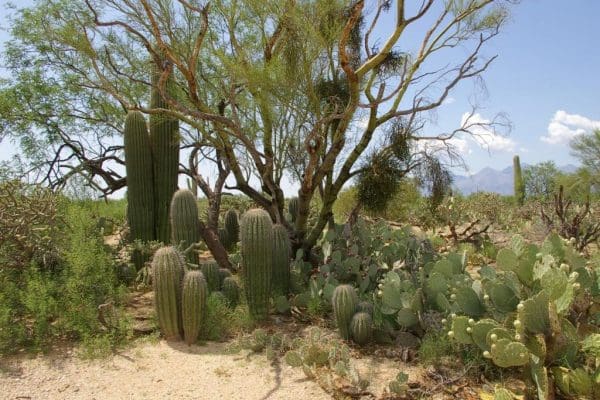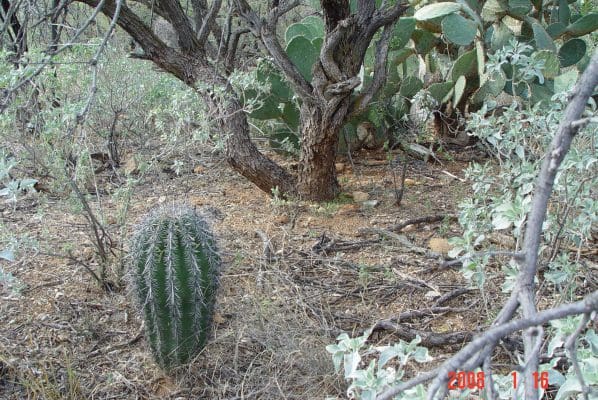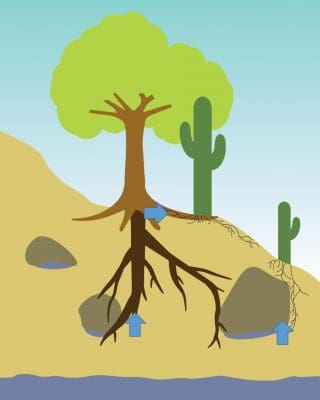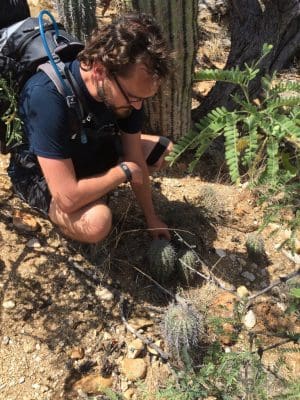
Babysitters Wanted - Saguaro cactuses seek desert nurse trees for permanent position
The sun rises over the Rincon Mountains east of Tucson, Arizona, beaming hues of orange, pink and purple into the sky. Warmth pours into the desert valley below. Plants and animals meet another scorching day with no clouds in sight. Too many successive rainless days could mean a drought is imminent.
Life in the Sonoran Desert has adapted to the annual rhythm of pounding summer storms and humming winter rains. Extended periods of drought, exacerbated by climate change, are devastating even to the saguaro cactuses that are adapted to live in arid habitats.
The Sonoran Desert of southern Arizona and Sonora, Mexico, is the only place in the world where these towering cactuses (Carnegiea gigantea) grow. Lying just east and west of Tucson, the two units of Saguaro National Park protect these giants, which are the largest cactuses in the United States. These slow growers can live up to 200 years and reach 70 feet in height, according to the park.
Western National Parks Association and Friends of Saguaro National Park are supporting research that monitors the health of the park’s namesake cactus. One project seeks to better understand why living under or near desert nurse trees can aid the saguaros’ survival. “Nurse plants can be thought of as an umbrella protecting the young saguaros from drying out on hot summer days and from freezing on cold winter nights,” said Cecil Schwalbe, an ecologist emeritus with the U.S. Geological Survey.
This research adds to evidence that young saguaros also receive a “water benefit” from their nurse trees.
Slow-and-steady growth
Statuesque saguaros are the living monuments of Saguaro National Park, which was established as Saguaro National Monument in 1933 to protect a forest of these giant cactuses east of Tucson. The monument was expanded in 1961 to include 25 square miles west of Tucson, and in 1994 the U.S. Congress elevated its status to a national park.
The saguaros’ arms stretch up to the sky in yoga poses. Their fleshy, ribbed green skin is covered in menacing inch-long black spikes. Spongy material below the skin can expand to store water when there is plenty, then contract as the cactus absorbs the water.
The roots of a saguaro have adapted to catch as much water as possible during a rainstorm. “The tallest saguaros only have a taproot about 1 meter (3 feet) deep, but roots close to the surface are extensive,” said Daniel Winkler, a research ecologist with the U.S. Geological Survey who conducted much of the new saguaro research. A network of shallow surface roots can soak up rainwater faster than a deep taproot can.
White flowers on top of a saguaro’s trunk and on the tips of its arms attract nectar-feeding bats, birds and insects. Pollinated flowers produce thousands of tiny black seeds inside bright red fruit. The fruit provides food for birds, bats, tortoises, javelinas, coyotes and humans. The seeds travel unharmed through the digestive system of animals and onto the ground in excrement.
While an adult saguaro can survive harsh conditions, its offspring often struggle to establish themselves. There are two notable periods of saguaro decline in recent history. From the 1930s through the 1960s the decline was thought to be caused by heavy cattle grazing and extensive tree clearing. The current decline is attributed to climate change, which has lengthened drought periods. Young saguaros are extremely sensitive to drought.
Saguaros growing under desert trees, such as mesquites, ironwoods and paloverdes, tend to thrive. Thorns covering the trees’ branches prevent cattle from trampling young saguaros. The trees also moderate the heat and cold fluctuations of day and night in the desert.
Temperature and moisture are poorly understood factors that help determine the fate of young saguaros. Scientists wanted to learn more about which sources of water are the most important for their growth.
New research at Saguaro National Park
The goal of this new research was to learn more about how a young saguaro benefits from growing under or near a nurse tree. The hypothesis was that the deep-rooted tree might inadvertently “share” the water that it lifts from deep below the ground.
Researchers set up soil moisture sensors and collected samples of groundwater and rainwater, as well as root tissues from saguaros and their nurse trees. The water samples were studied at the atomic level. A single molecule of water is usually two hydrogen atoms and one oxygen atom. A tiny fraction of water has a deuterium atom in place of a hydrogen atom and is commonly known as “heavy water.” Deuterium has an extra neutron that adds measurable mass.
The fraction of deuterium present in groundwater and rainwater is different, so the researchers could determine which type of water a young saguaro used at different times of the year. Winter’s gentle precipitation soaks deep into the soil because of lower plant transpiration and evaporation and is tapped by trees with deep roots. Scientists had thought that the shallow-rooted saguaros only take up water from the quick, powerful summer rains, which run off quickly.
The study revealed that saguaros use water year-round. By comparing the samples collected, the researchers learned that young saguaros likely access the deep groundwater that nurse trees draw to the surface. The sharing of water occurs when the trees’ shallow surface roots “sweat” during the hot, dry months.
Understanding saguaro growth patterns will help park biologists and managers make informed decisions that will protect young cactuses in the face of higher temperatures and prolonged drought. Understanding the potential importance of nurse trees to young saguaros’ survival will promote land management practices that lower the rate of tree clearing.
“I want the resources of the park to be available for future generations,” said Don Swann, a park biologist who took part in this research project.
Scientists have researched the saguaro for more than 100 years, but they still have much to learn. “Studying the saguaro cactus is the ultimate challenge because they have such a long lifespan,” Winkler said. “They outlive humans.”
By Alyssa Ellsworth, graduate student of chemistry and science communication at the University of Arizona
var jQ = jQuery.noConflict(); jQ(document).ready(function(){ jQ(window).load(function(){ var mySwiperG = new Swiper ('.swiper-container-gallery', { slidesPerView: 1, spaceBetween: 15, allowTouchMove: true, //freeMode: true, preloadImages: false, lazy: true, autoplay: { delay: 6000, }, scrollbar: { el: '.swiper-scrollbar', hide: false, }, navigation: { nextEl: '.swiper-button-next', prevEl: '.swiper-button-prev', }, breakpoints: { // when window width is >= 640px 578: { slidesPerView: 'auto' } } }); }); });







